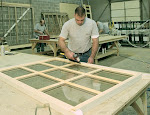Todd Maxwell and I drive people crazy with our obsession with windows. We often find ourselves making impromptu visits to project sites to evaluate window installations. Just yesterday for example, I was accosted by a security guard at the Nelson Atkins Museum of Art for inspecting their Profilit glass walls. This past week, Todd and I were traveling in Kentucky and Alabama when we ran across a couple of window restoration projects that displayed glaring quality defects. I thought that by sharing some of these conditions I could help you better navigate your next preservation project.
Most project construction documents and specifications outline all of the processes and materials to be utilized in the window restoration scope of work. The construction team focuses on what has to happen to make for a successful project. In this business climate where bids for the same scope of work can vary by 100% or greater, it is also important to focus on what definitely cannot happen on a project. The last thing you need to happen is for the low bidder to work substandard materials and abbreviated means and methods into your project. The following two projects we surveyed last week have some excellent examples of what should never happen on a window restoration project.
The first project involved a wood double hung window restoration where the existing frame, trim, and sash were to be restored, sash to be reglazed, and the entire system to be painted on the exterior and stained on the interior. The sash were to be set as fixed in the opening. Typically the window sash would be removed to be restored, glazed, and finished in an offsite environment. The frames would be abated in place and finished in the field. We discovered the following problems on this project:
The restoration contractor left the lifts, lock, and pull down hardware on the sash when it was stripped. The sash was then sanded without removing these elements. You can see by the picture below how the lift was sanded during this faulty process, causing scratch marks. You can also see evidence of stain that was not removed around the perimeter of the hardware since it was impossible to contact with sand paper.

Most sash have unique wood profiles on the stiles, rails, and muntins. One needs to be very careful not to excessively sand these profiles or they will be completely removed or distorted. We often have to replace sections of a sash because the original profile has been damage beyond repair. Take a look at the profiles on this sash for a good example of how not to sand during the restoration process.


We often run into sash that has interior cracks, scratches, or gouges. If the project calls for a stained interior, it is challenging to fill these areas with a custom color filler that will match the selected stain. The restoration contractor on this project found it acceptable to leave the gouges untreated. Should make for and interesting distressed look once it is stained. We shall call it historic hammered wood.


We run into sash with lugs on the lower sash quite frequently. It is important to restore these architectural elements since they are so visible from the interior. We often find interior lug damage. The following picture shows how this restoration contractor completely ignored the condition of the interior lugs.


Frame restoration is also a major part of a window refurbishment project. We spend a lot of time on the sills, brickmould, and mullion covers. We also run into missing or damaged weight pocket doors from time to time. These doors are designed so they can be secured with only one screw that holds them very tightly in place. Look how this piece of pine was scabbed in with a visible fastener and a wide crack to replace a missing weight pocket door.


In many cases existing frames and sash have to be completely replaced because they are missing or damaged beyond repair. We utilize a matching species of the finest grade of wood, or a durable hardwood like mahogany to provide replicated parts. We also cull through the material to eliminate defects like knots, cracks, checks, or worm holes. The framing material used in this project looks like pine that was recycled from a wood pallet. The exposed knot is not only an aesthetic problem but could be a structural one as well.


The original single pane glass on this project was reused in the sash. It is very challenging to find people who still know how to putty glaze windows. We spent months trying to find a replacement for a retired craftsman at Re-View. Take a look at the sloppy lines of this putty job.


We visited another project site that had hundreds of historic wood casement windows. The scope of work for this project included restoring the frames and the sash and then converting the sash to insulated glass. All of the sash work was conducted by a company that specializes in shop restoration of historic windows. We found major problems in both the sash and frame restoration on this project.
Converting a historic wood window sash from single pane to insulated glass is more complicated than it looks. The engineering of the muntins, the glazing materials, and the glass has to work in concert. If the glass size is incorrect or the glazing stops are installed improperly, you can have an unsightly sash that will leak and have seal failure in a matter of years. Take a close look at this IG conversion we ran across last week. The restoration contractor failed to use low profile spacer bars in the insulated glass so 1/8" or greater of the black spacer bar sealant is visible on both the interior and exterior. This black shadow could have been eliminated by using the proper type of glass and by measuring each lite with precision. At Re-View we measure each glass lite with a laser.

One of the most overlooked processes on a window restoration project is the application of finishes. The proper selection of finishes, prep work of the substrate, and application techniques are key to a good finish. Add in considerations like relative humidity, exposure to the sun, and temperature variances and you can see why it is challenging to achieve a quality paint job. Take a look at the picture below of a frame that was restored and finished only seven years ago. The contractor failed to neutralize the strippers used to remove the original finishes. This improper neutralization caused catastrophic failure of the new finishes. The result is a seven year old restoration project that looks worse than the windows did before they were refurbished.

Please feel free to contact Re-View to discuss historic window issues. One thing we like about this business is that we are always learning as well.
Converting a historic wood window sash from single pane to insulated glass is more complicated than it looks. The engineering of the muntins, the glazing materials, and the glass has to work in concert. If the glass size is incorrect or the glazing stops are installed improperly, you can have an unsightly sash that will leak and have seal failure in a matter of years. Take a close look at this IG conversion we ran across last week. The restoration contractor failed to use low profile spacer bars in the insulated glass so 1/8" or greater of the black spacer bar sealant is visible on both the interior and exterior. This black shadow could have been eliminated by using the proper type of glass and by measuring each lite with precision. At Re-View we measure each glass lite with a laser.

One of the most overlooked processes on a window restoration project is the application of finishes. The proper selection of finishes, prep work of the substrate, and application techniques are key to a good finish. Add in considerations like relative humidity, exposure to the sun, and temperature variances and you can see why it is challenging to achieve a quality paint job. Take a look at the picture below of a frame that was restored and finished only seven years ago. The contractor failed to neutralize the strippers used to remove the original finishes. This improper neutralization caused catastrophic failure of the new finishes. The result is a seven year old restoration project that looks worse than the windows did before they were refurbished.

Please feel free to contact Re-View to discuss historic window issues. One thing we like about this business is that we are always learning as well.






No comments:
Post a Comment